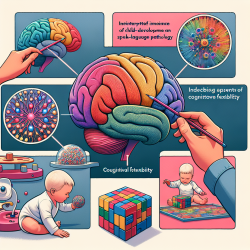Understanding DHX30-Associated Neurodevelopmental Disorders: A Guide for Practitioners
In the realm of neurodevelopmental disorders, recent research into DHX30-associated conditions offers groundbreaking insights that could transform therapeutic approaches. The study titled "Genotype–phenotype correlations and novel molecular insights into the DHX30-associated neurodevelopmental disorders" provides a comprehensive analysis of the clinical and genetic landscapes of these disorders. For practitioners, understanding these findings is crucial for enhancing child outcomes through data-driven strategies.
The DHX30 Gene and Its Role in Neurodevelopment
The DHX30 gene encodes an ATP-dependent RNA helicase, playing a pivotal role in RNA metabolism. Variants in this gene have been linked to a spectrum of neurodevelopmental disorders characterized by global developmental delay, intellectual disability, and severe speech impairment. The study identifies two distinct clinical subtypes based on variant location and type: a severe phenotype associated with helicase core motif (HCM) missense variants and a milder phenotype linked to loss-of-function variants.
Implications for Practitioners
For practitioners, these findings underscore the importance of genetic testing and personalized treatment plans. Here are some actionable steps to consider:
- Genetic Screening: Incorporate genetic testing in the diagnostic process to identify potential DHX30 variants. This can aid in tailoring interventions that address specific genetic profiles.
- Interdisciplinary Collaboration: Work closely with geneticists, neurologists, and other specialists to develop comprehensive care plans. The study highlights the value of interdisciplinary approaches in understanding and managing these complex disorders.
- Utilize Technology: Leverage online therapy platforms like TinyEYE to provide accessible and flexible speech therapy services. This can be particularly beneficial for children with severe speech impairments associated with DHX30 variants.
- Monitor and Adapt: Regularly assess the effectiveness of interventions and be prepared to adapt strategies based on ongoing research and patient progress.
Encouraging Further Research
The study exemplifies how functional analyses, coupled with clinical and genetic findings, can define clinically distinct subtypes for ultra-rare disorders. Practitioners are encouraged to stay informed about ongoing research and contribute to data collection efforts, which can enhance the understanding and treatment of DHX30-associated disorders.
To read the original research paper, please follow this link: Genotype–phenotype correlations and novel molecular insights into the DHX30-associated neurodevelopmental disorders.
Conclusion
The insights from the DHX30 study are invaluable for practitioners committed to improving outcomes for children with neurodevelopmental disorders. By integrating genetic insights into practice, practitioners can offer more targeted and effective interventions, ultimately enhancing the quality of life for affected children and their families.










